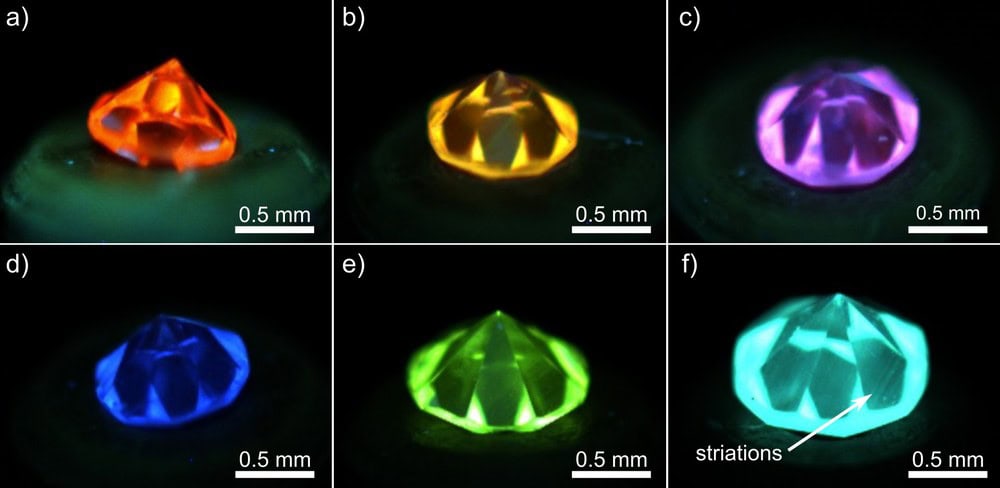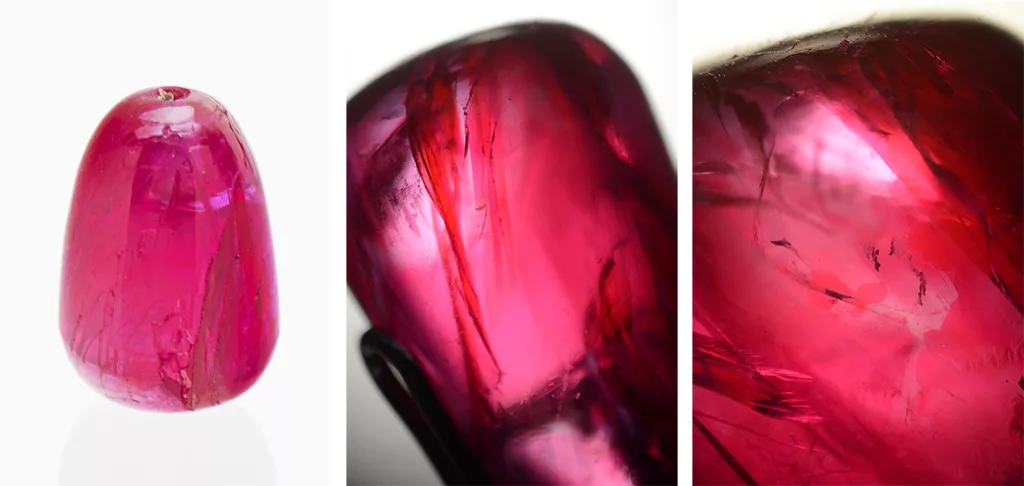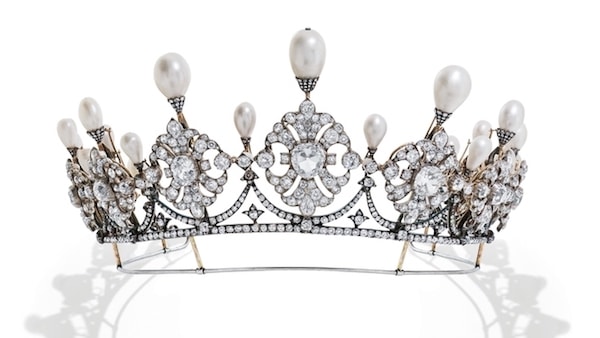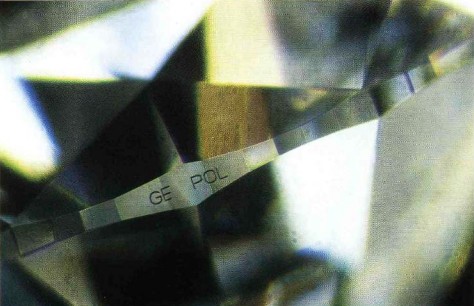
A descriptive study on as-grown and HPHT-treated CVD synthetic diamonds
By Dr. M. Mintrone, first published in Facette 29 (May 2024)

In a recent research project with Armin Spelina, a student of the University Basel, we investigated 20 synthetic diamonds (CVD) from a private donation with diameters between 0.9 and 1.2 mm. FTIR analyses showed that all the tested CVD samples are type IIa (i.e. no detectable nitrogen), which – to our knowledge and based on literature – is always the case for colourless CVD synthetic diamonds (Eaton-Magana et al., 2020). Under UV-lamp excitation, 19 of these CVDs display fluorescence colours that are rarely observed in natural diamonds (Fig. 1a, b, c, e, and f). The most observed fluorescence colours were green and greenish-blue. However, one CVD (Fig. 1d) exhibits a blue fluorescence, similar to the reaction commonly observed in natural diamonds. Due to the small size of the samples, typical CVD growth structures like striations were only visible in a few samples (Fig. 1f).
Photoluminescence (PL) analyses at low temperature (-196°C) showed that 8 of these synthetic CVDs were as-grown and 12 HPHT treated. The SiV defect (737 nm) was detected in all the investigated samples, which is a typical feature of CVD synthetic diamonds (Fig. 2a). As-grown synthetic CVD always displayed the 467 nm defect, and most showed the 596/597 nm centre, which is only present in CVD (Fig. 2a and b). As-grown synthetic CVD corresponds to the samples with red, reddish- orange, yellow, purplish-pink, and blue fluorescence colours.

In contrast, the 12 CVD samples displaying a green or greenish-blue fluorescence showed indications of HPHT treatment. HPHT treatments on CVD synthetic diamonds are generally performed to reduce their initial brownish coloration (Eaton-Magana et al., 2016). This is supported by the absence of the 467 nm centre (correlated with the brownish coloration, Zaitsez et al., 2021). Moreover, the absence of the 596/597 nm centre and the presence of aggregated nitrogen such as N3, H3, and H4 centres are strong evidence of HPHT treatment. Those CVD synthetic diamonds are also characterized by the presence of numerous peaks between 430-500 nm (Fig. 2a) and 520-580 nm (Fig. 2b) which is common in this type of CVD (Wang et al., 2012).
To summarize:
- Colourless CVDs described here are type IIa synthetic diamonds.
- Unusual colours of fluorescence such as red, orange, yellow, green, and greenish-blue could be used as a strong indicator. Nevertheless, note that some natural diamonds can exhibit such colours too. Moreover, blue fluorescence present in some CVD synthetic diamonds may lead to being misinterpretated as a natural diamond.
- Photoluminescence (PL) with different laser wavelengths remains the most sensitive tool to determine whether a diamond is natural or synthetic.
To conclude, the combination of all these analytical techniques is key to determine if diamond is natural, synthetic, or treated. However, PL and FTIR are not simple and cheap instruments easily accessible to customers who would like to check their diamonds themselves. Furthermore, testing small diamonds of melée size is challenging as their quantity and size can limit the analytical possibilities and greatly affects the duration of such testing. This is why SSEF developed the ASDI-500 (i.e. PL analysis) with our partners in Switzerland as a unique solution to screen diamonds as small as 0.5 mm.
For more information about the ASDI-500 instrument, please see: https://www.ssef-instruments.ch/asdi-500/
References
Eaton-Magaña. S., Shigley. J.E. 2016. Observations on CVD-grown synthetic diamonds: A review. Gems & Gemology, 52(3), 222-245. http://dx.doi.org/10.5741/GemS.52.3.222.
Eaton-Magaña. S., Ardon, T., Breeding, C.M., Shigley, J.E. 2020. Natural- color D-to-Z diamonds: A crystal-clear perspective. Gems & Gemology, 56(3), 318-335. http://dx.doi.org/10.5741/GEMS.56.3.335.
Linde, O., Epstein, A., Kravchenko, S., Rentmeesters, K. 2021. The Global Diamond Report. Bain and Company.
Wang. W., D’Haenens-Johansson, U.F.S., Johnson, P., Moe, K.S., Emerson, E., Newton, M.E., Moses, T. M. 2012. CVD synthetic Diamonds from Gemesis Corp. Gems & Gemology, 48(2), 80-97. http://dx.doi. org/10.5741/GEMS.48.2.80.
Zaitsev, A. M., Kazuchits, N. M., Moe, K.S., Butler, J.E., Korolik, O.V., Rusetsky, M.S., Kazuchits, V.M. 2021. Luminescence of brown CVD diamond: 468 nm luminescence center. Diamond and Related Materials, 113, ,108255. https://doi.org/10.1016/j.diamond.2021.108255.


